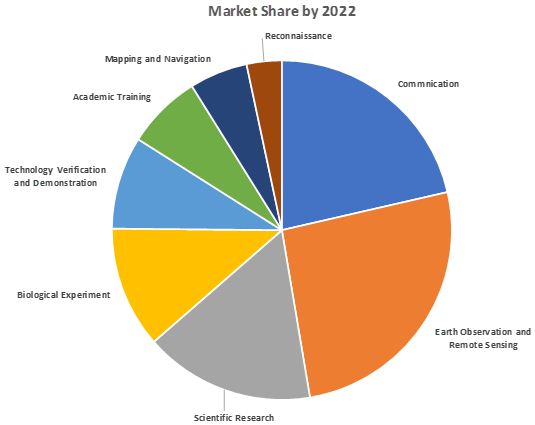According to new market research report "Nanosatellite and Microsatellite Market by Component (Hardware, Software & Data Processing, Services, Launch Services), Mass (1 kg-10 kg and 11 kg-100 kg), Application (Earth Observation & Remote Sensing), Vertical - Global Forecast to 2022", The nanosatellite and microsatellite market is expected to grow from USD 1.21 Billion in 2017 to USD 3.49 Billion by 2022, at a Compound Annual Growth Rate (CAGR) of 23.7% from 2017 to 2022. The market is primarily driven by the increasing investments in nanosatellite and microsatellite technologies, low manufacturing cost of miniature satellites, and high demand for miniature satellites in Earth observation applications.
Know More@ https://www.marketsandmarkets.com/Market-Reports/nanosatellite-and-microsatellite-market-130496085.html

Know More@ https://www.marketsandmarkets.com/Market-Reports/nanosatellite-and-microsatellite-market-130496085.html
The space industry has witnessed tremendous growth in the past two decades. Access to the latest technology for private players has fuelled the growth of the global market. Low manufacturing cost and shorter development cycle of nanosatellites and microsatellites are anticipated to drive the market growth. Moreover, it is now possible to have a global coverage with a constellation consisting of a few dozens of both, nanosatellites and microsatellites. With the entry of private players in the space industry, launching a satellite is not limited to government agencies of a country. Companies have established new frontiers in the space industry with the successful completion of missions using refurbished rockets to reduce the turnaround time of a rocket launch.
Miniaturization of electronics has helped in the development of compact and lightweight systems for space exploration and research projects related to the commercial, defines, and civil sectors. Advancements in miniaturization technology have enabled the development of nanosatellites and microsatellites, which result in cost savings in a space program, as small launch vehicles can be used, or satellites can be launched as secondary payloads. Various commercial as well as private ventures have made significant investments in companies operating in the nanosatellite and microsatellite market to capitalize on opportunities presented through low-cost small satellite missions related to communication, earth observation, and remote-sensing, biological experiments, and scientific research, among others.
The nanosatellite and microsatellite market encompass components such as hardware, software, data processing, and services. Services include technical or engineering expertise, system integration and maintenance, and testing and support required to plan, design, manufacture, and launch a satellite. The market are highly competitive and diversified with the presence of various large technology providers and service providers.
The 1kg-10kg (nanosatellite) segment of the market, by mass, is projected to grow at the highest CAGR during the forecast period, as nanosatellites can be used for high precision and complex space missions, such as remote sensing, navigation, maritime and transportation management, space and earth observation, disaster management, military intelligence, telecommunication, and other academic purposes. The benefits of shorter development time and low cost has fuelled an increase in space programs among the developing countries, and the freedom to integrate with advanced space technologies is propelling the growth of the 1kg-10kg (nanosatellite) segment.
Government, civil, commercial, defines, energy & infrastructure, and maritime & transportation are few of the verticals, with wide adoption of nanosatellite and microsatellite market. Nanosatellites and microsatellites are used in the commercial sector for high precision and complex space missions, such as remote sensing, navigation, maritime and transportation management, space and earth observation, disaster management, military intelligence, telecommunication, and other academic purposes.The implementation of stringent regulations by the International Telecommunication Union (ITU), an organization that regulates orbital slots and radio frequencies, can restrain the growth of the market in the near future. Key players in the nanosatellite and microsatellite market include the RUAG Group (Switzerland), Clyde Space, Inc. (U.K.), GS Sweden AB (GOMSpace) (Denmark), Sierra Nevada Corporation (U.S.), PLANET LABS, INC. (U.S.), TYVAK INC. (U.S.), Lockheed Martin Corporation (U.S.), Raytheon Company (U.S.), Innovative Solutions In Space (Netherlands), and SpaceQuest Ltd. (U.S.). These companies are focusing on the development of nanosatellites and microsatellites in collaboration with dedicated launch service providers.
The growth of market depends on the factors, such as low manufacturing cost of miniature satellites, high demand for miniature satellites in earth observation application, and increased investments in nanosatellite & microsatellite technologies.
Apart from established players in the market, the new entrants in the market are focusing on developing nanosatellites and microsatellites in collaboration with dedicated launch service providers. The key players in the market are focusing on deploying different applications in the nanosatellite and microsatellite market

No comments:
Post a Comment